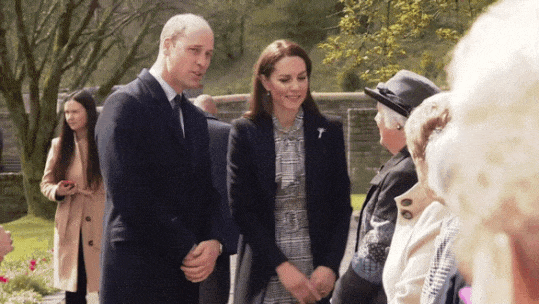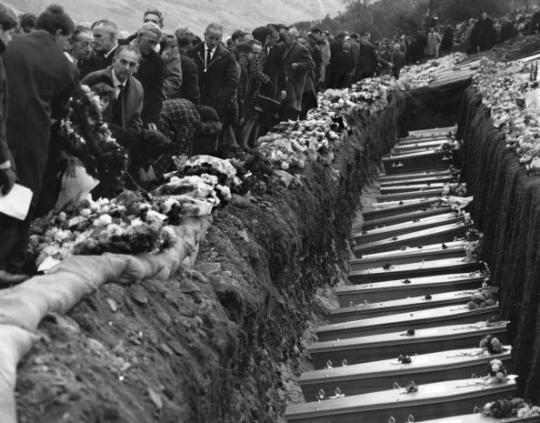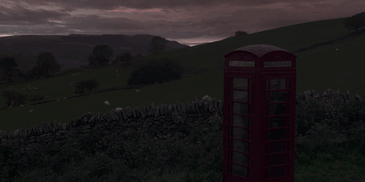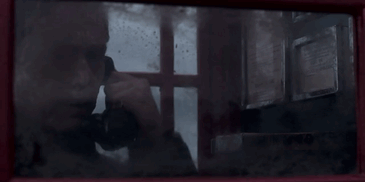#Pantglas Junior School
Explore tagged Tumblr posts
Text




Aberfan Disaster
On October 21, 1966, a massive coal waste tip crashed down the mountainside of the Welsh mining village Aberfan, killing 116 children and 28 adults. Pantglas Junior School was engulfed, and half the town's children died.
7 notes
·
View notes
Text










THE WALES DIARIES ♚
28 APRIL 2023 || Day 2 Wales Visit - Aberfan Memorial Garden, Aberfan
The Prince and Princess of Wales visited the Aberfan Memorial Garden which lies on the site where the Pantglas Junior School once stood to pay their respects to those who lost their lives in the disaster in 1966.
They were greeted by schoolchildren at the site, while survivor Gaynor Madgwick showed Kate a number of newspaper cuttings about previous royal visits to the area.
William and Catherine were then guided around the garden by one of the Aberfan survivors, David Davies, and Professor Peter Vaughan, Lord Lieutenant of Mid Glamorgan.
The Prince and Princess of Wales laid a floral tribute at the memorial and the message left by the couple, which read: 'In loving memory.'
They also met trustees from the Aberfan Memorial Trust who are involved in ensuring the maintenance of the garden. William and Catherine also met and spoke to also met the 12 surviving members of the Aberfan Wives Group and the last surviving teacher at the school, Mair Morgan, 81, who taught the five year olds.
During their visit they spent time to speak with the members of public. Catherine also had her bag and heart stolen by one year old Daniel Williams.
#british royal family#british royals#royalty#royals#brf#british royalty#kate middleton#catherine middleton#royal#princess of wales#the princess of wales#princess catherine#catherine wales.#the prince of wales#prince of wales#prince william#william wales.#my gifs#gifs#28.04.2023#aberfan memorial garden 23#wales visit apr 23#the prince and princess of wales#prince and princess of wales#engagement diaries#the engagement diaries#engagement diaries 23#the wales diaries 23#the wales diaries
108 notes
·
View notes
Video
tumblr
#PrinceWilliam and #PrincessKate are here at the Pantglas Junior School Memorial Garden in Aberfan.
They’re meeting survivors of the coal tip disaster that happened on this site in 1966. #PrinceandPrincessofWales -- South Wales News
#catherine elizabeth#princess catherine#princess of wales#princess catherine of wales#catherine the princess of wales#william arthur philip louis#prince william#prince of wales#prince william of wales#william the prince of wales#prince and princess of wales#william and catherine#kensington palace
94 notes
·
View notes
Text
Cofiwch Dryweryn - Remember Aberfan
On the 21st of October 1966, the mining village of Aberfan were suddenly robbed of an entire generation.
For decades, waste from the Merthyr Vale Colliery had been dumped on the hills above Aberfan, forming towering coal tips that loomed over the village. Despite repeated warnings from locals about the instability of these waste piles, especially one that sat on a natural spring, the National Coal Board ignored the risks. The autumn of 1966 brought weeks of heavy rain, saturating the tip and setting the stage for disaster.
That morning the children of Pantglas Junior School were excitedly looking forward to their half-day before the school holidays. As they finished singing All Things Bright and Beautiful, a deafening roar shattered the morning calm. In that split second, it felt as if time itself froze
For years, waste from the local coal mine had been piled high on the hillside above the village, despite warnings that it was unstable. Heavy rain had turned the tip into a ticking time bomb, and when it finally gave way, there was no time to escape
A landslide of 1.4 million cubic feet of coal waste came crashing down the mountain, burying the school and nearby homes. 144 lives were lost, 116 of them children.
Rescuers, many of them parents, clawed through the debris with bare hands, but the weight of the sludge left little hope. Rescuers would later find a clock stopped at 9:15
The disaster was entirely preventable. The coal tip had been built on ground that was known to be unstable, and despite warnings from villagers and workers, nothing was done. When the inquiry concluded, full blame was placed on the National Coal Board and several of its officials, but no one was ever prosecuted
And yet, nearly 60 years later, we are still dealing with the dangers of abandoned coal tips. In November 2024, heavy rainfall caused a coal tip in Cwmtillery, Blaenau Gwent, to partially collapse, forcing dozens of residents to evacuate. Many locals didn’t even know the tip was there until disaster struck
There are currently 2,573 disused coal tips in Wales, with 360 considered high-risk. Despite the clear danger, efforts to manage them have been slow, and residents fear history could repeat itself
In response to growing concerns, the Welsh government has proposed creating a Disused Tips Authority to oversee the safety of these sites, but for those living in their shadow, action can't come soon enough
Aberfan’s pain is still raw, and its warnings remain urgent. We cannot afford to forget.
2 notes
·
View notes
Text
British People: Some Historical Photos
On 21 October, 1966, a slag heap at Merthyr Vale colliery collapsed on to Pantglas Junior School in Aberfan village, killing 116 children and 28 …British People: Some Historical Photos

View On WordPress
0 notes
Text

29 October 1966 Evening Standard: Today the Queen went to a silent Aberfan to share its sorrow. She saw what had been the school; She spoke to parents who had lost their children when the mountain moved; She spoke to children who had escaped. The grief is etched on her and Prince Philip's faces and was echoed in her own words: 'There is nothing I can give them, but understanding and sympathy.' Pantglas Junior School, where this picture was taken, was overwhelmed in the avalanche of slurry eight days ago and many of its pupils are among the 147 known dead.
31 notes
·
View notes
Photo




The Aberfan disaster was 56 years ago today. Local people had been campaigning for years for the government and the Coal Board to remove the spoil tips above the village. It was, of course, deemed far too expensive.
Tip 7 - which had suffered two smaller slips in 1963 - was 111ft high by 1966, overlaying a natural spring, and after three weeks of heavy rain it became so saturated it slipped down the mountain. The first pic shows how it smashed through residential houses and straight into Pantglas Junior School.
The timing of it was so disgustingly cruel. It was the last day of term - so if it had happened a few hours later the school would have been empty as the day was finishing at noon. Morning assembly had just ended and at 9:15 the kids were settling down in their classrooms - so if it had happened a few minutes earlier most of the kids would have survived, as the hall was relatively undamaged.
As it was, the spill buried the classrooms, so most of those the avalanche didn’t kill instantaneously slowly suffocated as rescuers attempted to dig them out. Only 27 were eventually pulled out alive, one of those dying en route to hospital, and after 11am there were no more survivors, though body retrieval took a full week.
In total 144 people died - 28 adults and 116 children, the majority aged between 7 and 10.
I was Mayor for a nearby borough the year of the 50th anniversary so had to go to a lot of memorials, etc, and it was so unbelievably upsetting even after all that time. Just the age old story of human life mattering less than money and convenience, culminating in rows of little white gravestones.
20 notes
·
View notes
Photo





55 years ago today 116 little children went to school and didn't come home. Together with 28 adults they perished when a towering coal tip above the Pantglas Junior School, Aberfan, Merthyr Tydfil, Wales collapsed and came sliding down the mountain until it buried the school.
https://aberfan.walesonline.co.uk/
22 notes
·
View notes
Photo



Holding back his own feelings was difficult for Tony, but as he said later: “You couldn’t cry. It’s showing your emotions too much and you shouldn’t if you’re down to help. It’s a bit like a doctor crying. Also, crying when they have lost their children is almost impertinent." - Anne de Courcy, “Snowdon: The Biography” (2008).
October 21 1966: The Aberfan disaster was the catastrophic collapse of a colliery spoil tip in Wales on 21 October 1966. The tip had been created on a mountain slope above the village of Aberfan, near Merthyr Tydfil, and overlaid a natural spring. A period of heavy rain led to a build-up of water within the tip which caused it to suddenly slide downhill as a slurry, killing 116 children and 28 adults as it engulfed Pantglas Junior School and other buildings. The tip was the responsibility of the National Coal Board, and the subsequent inquiry placed the blame for the disaster on the organisation and nine named employees.
Ben Daniels as Antony Armstrong-Jones, Lord Snowdon // 3x03 - “Aberfan” of The Crown (2019).
#ben daniels#the crown#perioddramaedit#my gifs#bd the crown edit#tv series#antony armstrong jones#lord snowdon
40 notes
·
View notes
Photo


Lord Snowdon visits Aberfan in South Wales following the tragic disaster on 21 October 1966, in which an avalanche of waste material from the nearby coal mine cascaded downhill and into the local village, engulfing Pantglas Junior School and other buildings in the area - killing a total of 116 children and 28 adults.
Of Welsh background himself, Snowdon spontaneously took a train from London alone, in the second-class carriage with only a small suitcase containing pyjamas and a shaving kit. The first member of the Royal Family to make the visit, he arrived in Cardiff at 2am, the morning after the tragedy, and was then driven up to Aberfan. He left the emergency services to their carry on their rescue attempts and focused on providing comfort to parents, 50 of whom were waiting in Bethania chapel to identify the bodies of their children.
According to his biographer, Anne de Courcy, Anthony “made it his job to visit the bereaved relatives, sitting holding the hands of a distraught father, sitting with the head of a mother on his shoulder for half an hour in silence. In another house he comforted an older couple who had lost thirteen grandchildren - in another where they were terribly upset, he offered to make a cup of tea, went into the kitchen and returned with a tray with cups for them all. He helped an older man persuade his son, who was clutching something in his tightly clenched fist, to open his hand. It was a prefect's badge, the only thing by which he had been able to identify his child..."
"Darling, it was the most terrible thing I have ever seen." - Lord Snowdon in a letter to his wife, Princess Margaret.
292 notes
·
View notes
Text




Aberfan Disaster
On October 21, 1966, a massive coal waste tip crashed down the mountainside of the Welsh mining village Aberfan, killing 116 children and 28 adults. Pantglas Junior School was engulfed, and half the town's children died.
6 notes
·
View notes
Text
ABERFAN
I wished we had known about Aberfan before we traveled through Wales. We would have visited that little hamlet to pay our respects. Although the horrific catastrophe took place over 50 years ago, I wonder if that community has ever really healed. Losing half the town’s population of children, 116, and 28 adults in a matter of moments is something which, I imagine, you can never really ever put…
View On WordPress
#Aberfan#avalanche#coal debris#coal mines#National Coal Board#Pantglas Junior School#school children#slurry#tragedy#Wales
0 notes
Text







Today 52years ago a landslide of coal slid down a mountain and engulfed Pantglas Junior School in Aberfan rip to the 116 children and 28 adults we remember them
6 notes
·
View notes
Text
See the moving Aberfan disaster poem performance to mark the tragic anniversary
October 21, 1966, saw the youngest and most vulnerable pay the highest price for the coal hewn from the ground, as the waste collided with Pantglas Junior School. การพนันออนไลน์
0 notes
Text
#Aberfan, 55 years on. 🖤
21.10.1966 144 9.13AM, concrete & steel. It contains 144 clocks – the number of adults & children who died when a colliery spoil tip collapsed into homes & Pantglas Junior School. Clocks are set to 9.13am - the time of the disaster on October 21, 1966.

0 notes
Photo






1966
Inflation grew as part of the effect to fund the war in Vietnam. Both the U.S. and USSR continued in their space race to see who would be the first to land a man on the moon. Race riots continued to increase across cities in America, and national guards were needed to bring back law and order. The fashions in both America and UK came from a small well-known street in London, Carnaby Street. Both women and men wore patterned pants and flowered shirts and boots, even caps utilized plastic and vinyl for a wet, shiny look. The most popular groups included the Beach Boys (with Pet Sounds), the Rolling Stones (with Aftermath), and the Beatles (with Revolver).
Major events
• Up to 200,000 people attend anti-Vietnam war protests around the world.
• Miranda Rights come into being after the U.S. Supreme Court overturns the conviction of a confessed rapist, ruling that he had not been properly informed of his right to council and to not testify against himself.
• In South Wales, on October 21, a slag heap containing unwanted rock from the local coal mine slid down Merthyr Mountain. As it collapsed, it destroyed twenty houses and a farm, before going on to demolish virtually all of Pantglas Junior School. 144 people were killed, 116 of whom were children (mostly between the ages of 7 and 10). This became known as the Aberfan Disaster.
• The U.S. Department of Transportation is created.
• The Gemini 8 space mission is aborted early after technical difficulties interrupt the mission.
• The Gemini 10 space mission launches and is completed successfully.
• NASA launches Lunar Orbiter 1, the first U.S. spacecraft to orbit the Moon.
• The ATS-1 (Applications Technology Satellite) was launched by NASA during December. The ATS-1 was an experimental satellite that weighed about 750 pounds. It carried several experiments, including 2 for meteorological purposes. One of the experiments took full disk hemispheric images of the Earth every half hour. ATS-1 remained operational as it orbited around the Equator until December 1978, when it was deactivated.
• Soviet Union lands Luna 9 on the moon in February, and the U.S. follows with the Surveyor 1 soft moon landing in June.
• NASA’s final Gemini mission, Gemini 12, was launched during November. Gemini 12 carried Buzz Aldrin and James Lovell into space where they carried out several experiments during its four day mission. The main purpose of the mission was to conduct several periods of extravehicular activity, which they did successfully. The astronauts also performed a docking with the Agena spacecraft. The Gemini program paved the way for future missions in the Apollo program, which also led to the moon landing.
• The USSR’s Luna 10 spacecraft becomes the first man-made object to orbit the Moon.
• Batman, Star Trek, and The Monkees are among the new TV shows.
• Miniskirt comes into fashion.
• U.S. Population exceeds 195 million.
• The Black Panthers are formed in the U.S.
• Richard Speck murders 8 nurses in Chicago, Illinois.
• Ex-Marine Charles Whitman kills 14 and injures 31 on a killing spree at the University of Texas.
• U.S. has nearly 500,000 troops in Vietnam.
• The Draft Deferment Test is started in the U.S., as a way for students to convince the Draft Board that they would serve the nation better in the quiet of the classrooms rather than in the jungles of Vietnam.
• Race riots happen in Atlanta, and Black Power becomes a significant factor in American politics.
• The Subway Strike in New York brings the city to a stop. Within a few days, the union’s demands are met with a 15% pay rise.
• Ronald Reagan enters politics, becoming Governor of California.
• Canada introduces its earnings-related social insurance program, the Canada Pension Plan (CPP).
• The Salvation Army celebrates 100 years.
• All cigarette packets in the U.S. must carry the health warning “Caution! Cigarette smoking may be hazardous to your health."
• 4 people dig under the Berlin Wall to gain freedom from East Germany.
• The Arno River floods cause the flooding of the city of Florence, in Italy, with thousands of historic books, manuscripts and fine art destroyed.
• 200,000 face starvation on the island of Lombak, Indonesia.
• Cassius Clay defeats Henry Cooper in two title fights in London.
• Pakistani-Indian peace negotiations end successfully.
• Indira Gandhi is elected Prime Minister of India.
• The Australian dollar was introduced at a rate of two dollars per pound, or ten shillings per dollar.
• Pope Paul VI and Arthur Michael Ramsey, the Archbishop of Canterbury, meet in Rome—the first official meeting between the Roman Catholic and Anglican churches in 400 years.
• An earthquake in Turkey leaves 2,394 dead and 10,000 injured.
• Ian Brady and Myra Hindley (known as “the Moors Murderers”) are sentenced to life in prison for the murder of 3 children.
• The UK implements much tougher new drink driving laws.
• England defeats Germany to win at the 1966 World Cup.
• China launches China’s Cultural Revolution and begins purging intellectuals.
• Barbados, Botswana, and Lesotho achieve independence.
• Harold Wilson and the Labour Party win the British General Election.
• Jacqueline Susann has her first novel, Valley of the Dolls, published.
• Dr. Seuss’ How the Grinch Stole Christmas, the animated television special adapted from the book, is shown for first time on CBS.
Top 10 highest-grossing films in the U.S.
1. The Bible: In the Beginning… (dir. John Huston)
2. Hawaii (dir. George Roy Hill)
3. Who’s Afraid of Virginia Woolf? (dir. Mike Nichols)
4. The Sand Pebbles (dir. Robert Wise)
5. A Man for All Seasons (dir. Fred Zinnemann)
6. The Good, the Bad and the Ugly (dir. Sergio Leone)
7. Lt. Robin Crusoe, U.S.N. (dir. Byron Paul)
8. The Russians Are Coming, the Russians Are Coming (dir. Norman Jewison)
9. Grand Prix (dir. John Frankenheimer)
10. Blowup (dir. Michelangelo Antonioni)
Billboard’s number-one music albums (in chronological order)
1. “Whipped Cream and Other Delights” by Herb Alpert & the Tijuana Brass
2. “Rubber Soul” by The Beatles
3. “Going Places” by Herb Alpert & the Tijuana Brass
4. “Ballads of The Green Berets” by SSgt. Barry Sadler
5. “If You Can Believe Your Eyes and Ears” by The Mamas & the Papas
6. “What Now My Love” by Herb Alpert & the Tijuana Brass
7. “Strangers in the Night” by Frank Sinatra
8. “Yesterday and Today” by The Beatles
9. “Revolver” by The Beatles
10. “Supremes A’ Go-Go” by The Supremes
11. “Doctor Zhivago Soundtrack” by various artists
12. “The Monkees” by The Monkees
Source: [x]
151 notes
·
View notes